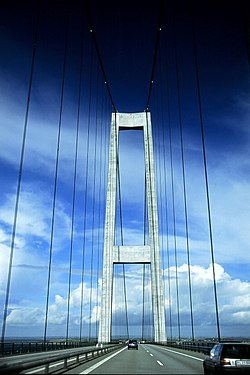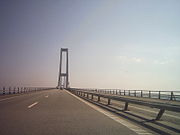Great Belt Bridge
From Wikipedia, the free encyclopedia.
The Great Belt Bridge (Danish: Storebæltsbroen) is a suspension bridge that is part of the fixed link across the Great Belt in Denmark.
The fixed link across the Great Belt was to be constructed in two phases, the first for railway transport and the second for road transport. The Great Belt Link was opened in June 1997 (the railway link) and in June 1998 (the road link).
Contents |
Construction
The construction of the fixed link across the Great Belt became the biggest building project ever in the history of Denmark. In order to connect Halsskov on Zealand with Knudshoved on Funen, 18 kilometres to its west, a two-track railway and a four-lane motorway had to be built, aligned via the small islet Sprogø in the middle of the Great Belt. In general terms, the project comprised three different construction tasks: The Eastern Bridge for road transport, the Eastern Tunnel for rail transport and the Western Bridge for road and rail transport combined.
The Eastern Bridge between Zealand and Sprogø is 6,790 metres long, and with a free span of 1,624 metres, is the world's second largest suspension bridge. The vertical clearance for ships is 65 metres. At 254m above sea level, the two pylons of the Eastern Bridge are the highest points in Denmark.
The Western Bridge between Sprogø and Funen is 6,611 metres long, and has a vertical clearance for ships of 18 metres.
The twin bored tunnel tubes of the Eastern Tunnel are 8 kilometres long each. Between the two main tunnels there have been established 31 connecting tunnels at 250 metre intervals. The equipment that is necessary for train operation in the tunnels has been installed in the connecting tunnels. The connecting tunnels also serve as emergency escape routes.
Traffic volume
Prior to the opening of the link, an average of 8,000 cars used the ferries across the Great Belt every day. In 2004, an average of 23,700 cars travelled the link each day. The increase of the traffic volume is partly caused by the general growth of traffic, partly diversion of traffic volume from other ferry services, and finally the so-called traffic leap, that is, new traffic generated by the improved ease, facility and low price of crossing the Great Belt.
The environment
Environmental considerations have been an integral part of the construction project of the fixed link across the Great Belt, and have been of decisive significance for the choice of alignment and determination of the design of the construction. Environmental considerations were the reason why the Great Belt A/S established an environmental monitoring programme in 1988, and initiated co-operation with authorities and external consultants on the definition of environmental concerns during the construction work and the professional requirements to the monitoring programme. This co-operation issued in a report published at the beginning of 1997 on the state of the environment in the Great Belt. The conclusion of the report was that the marine environment was at least as good as before the construction work began.
As concerns the water flows, the Great Belt Link must comply with the so-called zero-solution. This has been achieved by deepening parts of the Great Belt, so that the water flow cross section has been increased. This excavation compensates for the blocking effect caused by the bridge pylons and approach ramps. The conclusion of the report concerning the water flows is that the flow is now almost at the level it was at before the bridge was built. The fixed link across the Great Belt has generated increased road traffic volume, which in itself has meant increased air pollution. However, there has been significant savings in the energy consumption of the east-west traffic by switching from ferries to the fixed link. Train and car ferries consume much energy for propulsion. High-speed ferries consume large amounts of energy at high speeds. Also air transport is highly energy consuming.
The larger energy consumption by ferry transport as opposed to transport via the fixed link is most clearly seen when comparing short driving distances from areas immediately east or west of the link. For more extended driving distances the difference in energy consumption is smaller, but any transport within Denmark’s borders that goes east-west across the link shows very clear energy savings.
Road and rail user advantages
The fixed link has produced considerable time savings for travel and transport between eastern and western Denmark. Previously, the average time consumption involved in car transfer by ferry across the Great Belt was approximately 90 minutes, including the waiting time at the harbours. The time consumption was considerably higher during peak volume periods, that is, weekends and holidays. After the opening of the Great Belt Link, the time consumption has fallen to approximately 10 to 15 minutes.
For those who travel by train, the timesavings are even greater. The travel time has been reduced by 60 minutes, and there are many more seats available than previously, because more railway cars may be added to a train when this train does not have to fit into a ferry. The total seating capacity offered by DSB across the Great Belt on an ordinary Wednesday has risen from 11,060 seats to 37,490 seats. On Fridays the seating capacity exceeds 40,000 seats.
On the following stretches the shortest travel times are as follows: Copenhagen-Odense 1 hour 15 minutes, Copenhagen-Aarhus 2 hours 30 minutes, Copenhagen-Aalborg 3 hours 55 minutes and Copenhagen-Esbjerg 2 hours 35 minutes.
Accidents
The Western bridge has been crashed into twice. While the link was still under construction on September 14, 1993, the ferry M/F Romsø drifted off course in bad weather and hit the Western bridge.
At 19:17 on March 3, 2005, the 3,500-ton freighter M/V Karen Danielsen crashed into the Western bridge 800 metres from Funen. All traffic across the bridge was closed, effectively separating Denmark in two. It was re-opened shortly after midnight, after the freighter was pulled free and inspectors had found no structural damage to the bridge.
The Eastern bridge has so far been in the clear, although on May 16, 2001, the bridge was closed for 10 minutes as the Cambodian 27,000-ton bulk carrier "Bella" was heading straight for one of the anchorage structures. The ship was deflected due to a swift response from the navy.
External links
- Great Belt Bridge
- Image
- Map
- Satellite photo from Google Maps
- The Great Belt Bridge nearly hit by cargo ship from the Ingeniøren magazine, May 16, 2001 (in Danish)
- Rammed ship: Skipper was drunk from News24, describing the March 3, 2005 collision
- Mate was intoxicated; similar news story from DR, with additional background (in Danish)



